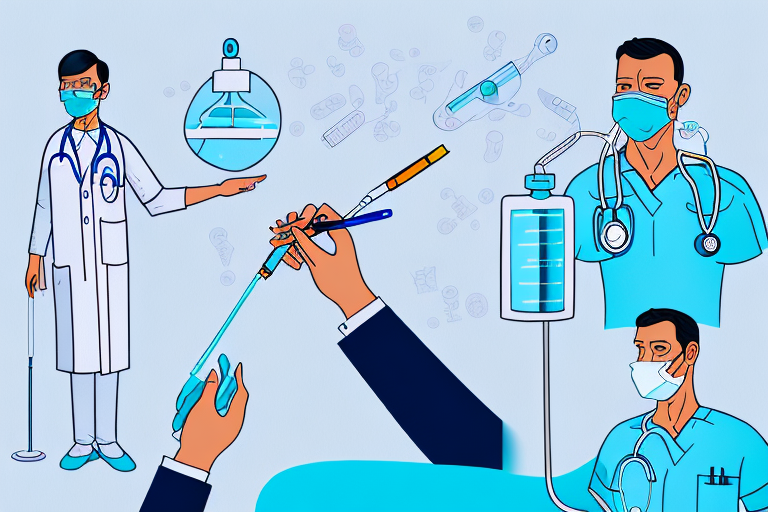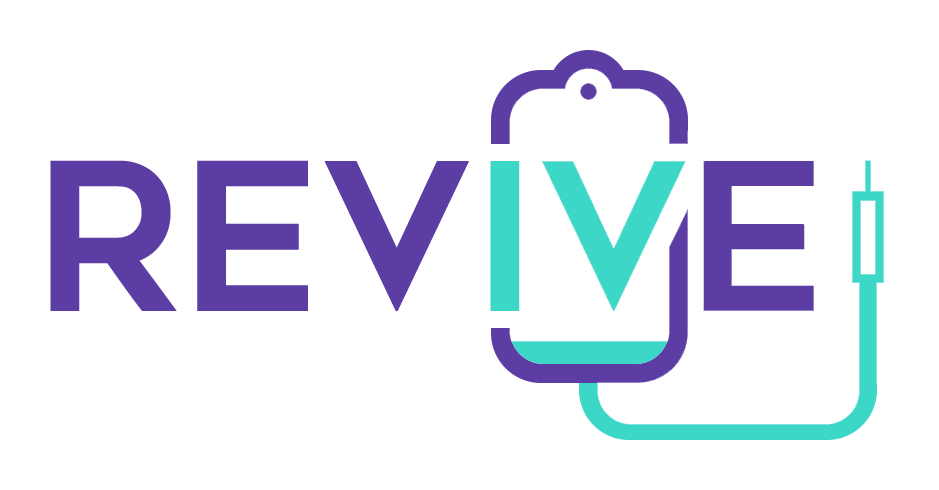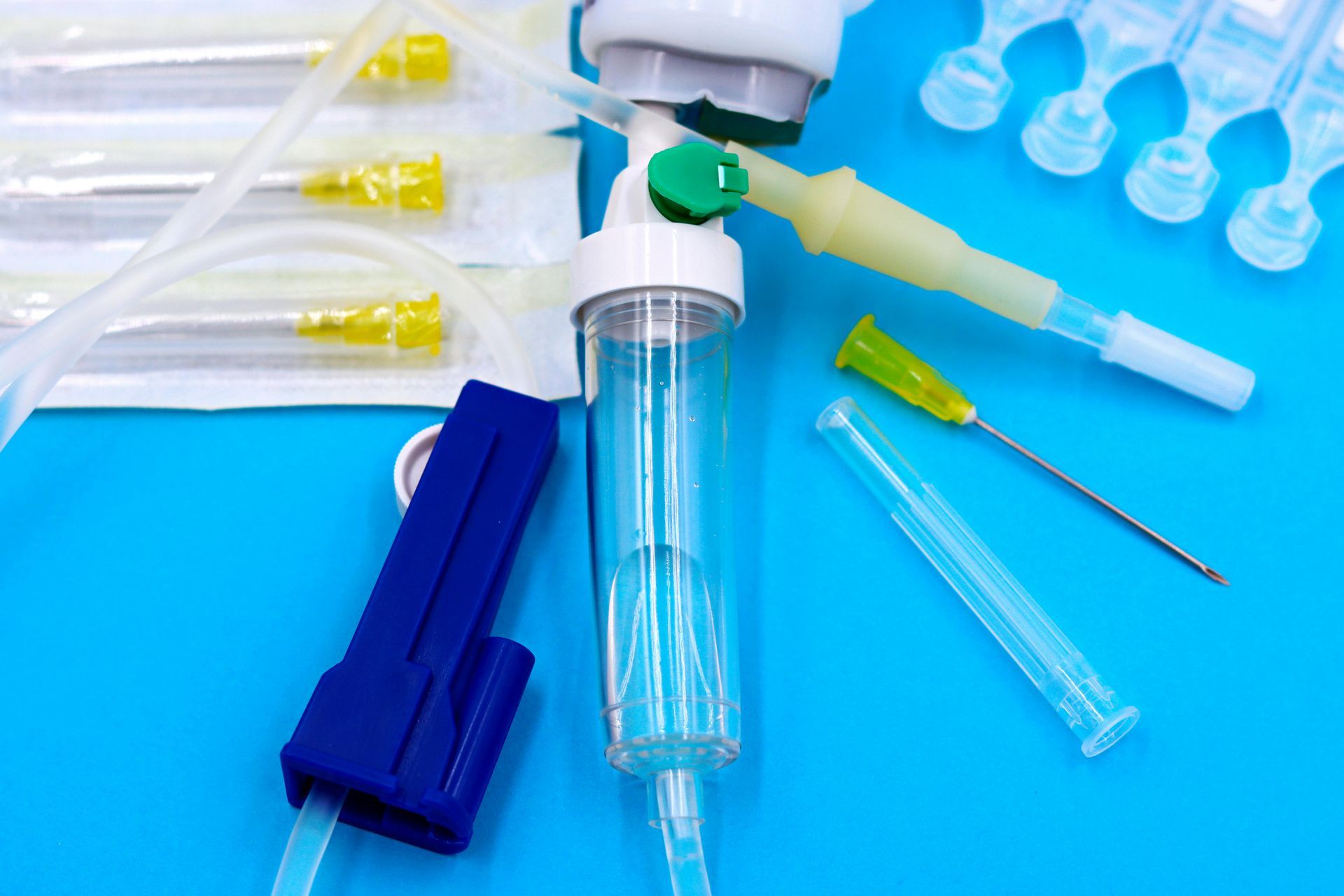IV Therapy 101: A Comprehensive Guide to Understanding Intravenous Therapy

Intravenous (IV) therapy is a common medical technique used to deliver fluids, nutrients, and medications directly into a patient's bloodstream through a vein. This method of administration provides rapid results and a more controlled delivery of essential substances, making it an essential tool for both medical professionals and patients. To gain a better understanding of this process, we will explore the history, science, types, components, procedure, risks, and future of IV therapy in this comprehensive guide.
What is Intravenous Therapy?
Intravenous therapy, commonly known as IV therapy, is a medical technique used to deliver fluids and medications directly into a patient's veins. This method is used when the patient is unable to take medications orally or when the medication needs to be delivered quickly. IV therapy is an essential tool for delivering life-saving treatment, as it provides immediate access to patients in critical conditions.
IV therapy is a crucial part of modern medicine and is used in a variety of medical settings, including hospitals, clinics, and emergency rooms. The procedure is performed by trained medical professionals, such as nurses and doctors, who are skilled in inserting and managing IV catheters.
The History of IV Therapy
The practice of
intravenous therapy dates back to the 17th century. In 1656, Sir Christopher Wren, an English scientist, used a quill and a tube to inject wine into a dog's vein. The first successful blood transfusion using IV therapy was performed by Dr. Richard Lower in 1665. In 1831, a Scottish physician named Dr. Thomas Latta used saline solution for the first time in IV therapy. Since then, IV therapy has evolved into a standard medical practice and has become fundamental to modern healthcare.
The Science Behind IV Therapy
Intravenous therapy works by delivering fluids, medications, or nutrients directly into the bloodstream through a vein. The substances are absorbed faster and the delivery is more controlled than other routes of administration. In addition, IV therapy bypasses the digestive system, ensuring that the substances are not broken down or eliminated before they are delivered into the bloodstream.
IV therapy is an effective way to deliver medication, nutrients, and other essential substances into the patient's body. The procedure is also used to maintain electrolyte balance and to replace lost fluids due to dehydration or blood loss.
Common Uses and Applications
IV therapy is used to treat a variety of conditions, including dehydration, infections, and cancer. It is also commonly used to deliver medications, such as antibiotics, painkillers, and chemotherapy drugs. IV therapy is also essential for patients undergoing surgery, as it provides the necessary fluids and medications to support the body during and after the procedure.
IV therapy is also used in emergency situations, such as in cases of severe dehydration or shock. In these cases, IV therapy can quickly deliver fluids and medications to stabilize the patient's condition.
Overall, IV therapy is an essential tool in modern medicine, providing a quick and effective way to deliver life-saving treatment to patients in need.

Types of IV Therapy
When it comes to healthcare, intravenous therapy is one of the most common and effective treatments available. IV therapy involves the delivery of fluids, medications, and nutrients directly into the patient's bloodstream through a vein. There are several types of IV therapy that are commonly used in healthcare. Each type of IV therapy has a specific purpose and is tailored to meet the needs of the patient.
Hydration Therapy
Hydration therapy is used to treat dehydration, which is a common condition that can occur due to excessive sweating, vomiting, diarrhea, or other health conditions. Dehydration can be dangerous if left untreated, as it can lead to electrolyte imbalances, organ failure, and even death. During hydration therapy, fluids are delivered into the patient's bloodstream to help restore hydration levels to normal. This type of IV therapy is also used to provide electrolytes and other essential substances that are lost during dehydration.
Hydration therapy can be used in a variety of settings, including hospitals, clinics, and even at home. In some cases, athletes may use hydration therapy to help them recover after a strenuous workout or competition.
Nutrient Infusion Therapy
Nutrient infusion therapy involves the delivery of vitamins, minerals, and other nutrients directly into the bloodstream. This method is commonly used in patients who have malabsorption issues, such as those with Crohn's disease or celiac disease. Nutrient infusion therapy is also used to boost the immune system, increase energy levels, and promote overall health and wellness.
Nutrient infusion therapy can be particularly beneficial for patients who have difficulty absorbing nutrients through their digestive system. By delivering nutrients directly into the bloodstream, the body can more easily absorb and utilize them.
Medication Administration
IV therapy is commonly used to deliver medications, such as antibiotics, painkillers, and chemotherapy drugs. This method is often used for patients who cannot tolerate oral medications or need rapid relief from their symptoms. IV medication administration ensures that the medication is delivered directly to the bloodstream, providing fast and effective relief.
Medication administration via IV therapy can be particularly useful in emergency situations, where time is of the essence. For example, a patient who is experiencing a heart attack may receive medication via IV therapy to help alleviate their symptoms and prevent further damage to their heart.
Blood Transfusions
Blood transfusions are a common application of IV therapy. This involves the transfer of blood or blood products (such as plasma or platelets) directly into the patient's bloodstream through a vein. Blood transfusions are used to treat a variety of conditions, such as anemia, bleeding disorders, and cancer.
For patients who require a blood transfusion, IV therapy is often the most effective way to deliver the blood products they need. This is because the blood products can be delivered directly into the bloodstream, where they can quickly and effectively begin to do their job.
In conclusion, IV therapy is a versatile and effective treatment option that can be used to treat a wide range of conditions. Whether a patient needs hydration therapy, nutrient infusion therapy, medication administration, or a blood transfusion, IV therapy can provide fast and effective relief.

Components of an IV System
There are several components of an IV system that are required to deliver fluids, medications, or nutrients directly into the patient's bloodstream. These components work together to ensure that the patient receives the appropriate treatment and that the IV system functions properly.
IV Catheters
IV catheters are thin, flexible tubes that are inserted into a vein to deliver fluids, medications, or nutrients. They are available in various sizes and are chosen based on the specific needs of the patient. IV catheters can stay in place for several hours or days, depending on the treatment plan.
When inserting an IV catheter, it is important to select the appropriate vein and to ensure that the catheter is inserted at the correct angle and depth. The site of insertion should be cleaned and disinfected to prevent infection. Once the catheter is in place, it should be secured to the patient's skin to prevent movement and dislodgement.
IV Tubing and Connectors
IV tubing and connectors are essential for delivering fluids and medications through the IV catheter. The tubing is connected to the catheter on one end and to the IV bag or syringe on the other. The connectors ensure a secure connection between the tubing and the catheter, preventing leakage or disconnection.
When setting up an IV system, it is important to check the tubing and connectors for any defects or damage. The tubing should be primed with the appropriate fluid or medication before connecting it to the patient's catheter. This ensures that any air bubbles are removed from the tubing and that the substance being delivered is at the correct concentration.
IV Fluids and Additives
IV fluids and additives are used to deliver essential substances into the patient's bloodstream. The most common types of IV fluids are saline solution and dextrose solution, which are used to treat dehydration. Additives, such as electrolytes, vitamins, or medications, may also be added to the fluids, depending on the needs of the patient.
When administering IV fluids and additives, it is important to monitor the patient's response to the treatment. The rate of infusion may need to be adjusted based on the patient's condition and fluid balance. It is also important to check the IV bag or syringe for any signs of contamination or expiration.
Infusion Pumps and Controllers
Infusion pumps and controllers are used to regulate the flow rate of fluids and medications into the patient's bloodstream. The pump ensures that the substances are delivered at a constant rate and in a controlled manner. The controller is used to adjust the settings of the pump and to monitor the patient's response to the treatment.
When using an infusion pump, it is important to set the appropriate flow rate and to monitor the patient for any signs of adverse reactions or complications. The pump should be checked regularly for any malfunctions or errors. The controller should also be used to monitor the patient's vital signs and to adjust the treatment plan as necessary.
The IV Therapy Procedure
The IV therapy procedure involves several steps, from preparing the patient to monitoring the infusion. IV therapy is a medical treatment that delivers fluids, medication, or nutrition directly into a patient's bloodstream. It is a common procedure performed in hospitals, clinics, and other healthcare settings.
Preparing for IV Therapy
Before IV therapy can begin, the patient must be prepared for the procedure. This involves selecting the appropriate catheter, choosing the correct fluids or medication, and ensuring that the IV site is clean and sterile. The healthcare provider will assess the patient's medical history and current condition to determine the best type of catheter and fluid to use. The IV site will be cleaned with an antiseptic solution to reduce the risk of infection.
Additionally, the healthcare provider will explain the procedure to the patient and answer any questions they may have. The patient may be asked to fast or refrain from certain activities before the procedure, depending on the type of IV therapy.
Inserting the IV Catheter
Once the patient is prepared, the IV catheter can be inserted into a vein. This is typically done by a trained healthcare professional, who will use a sterile technique to ensure that the site is clean and safe. The healthcare provider will select the appropriate vein for the catheter based on the patient's medical history and current condition.
The healthcare provider will use a needle to puncture the skin and enter the vein. Once the needle is in the vein, a small plastic tube called a catheter is inserted through the needle and into the vein. The needle is then removed, leaving the catheter in place.
The healthcare provider will secure the catheter to the patient's skin with tape or a dressing. The catheter may also be connected to an infusion pump, which delivers the fluids or medication at a controlled rate.
Monitoring the Infusion
During IV therapy, the patient's vital signs will be monitored to ensure that the treatment is progressing safely and effectively. The healthcare provider will check the patient's blood pressure, heart rate, and respiratory rate regularly. They will also monitor the patient for any signs of adverse reactions, such as an allergic reaction or infection.
The infusion pump will also be monitored to ensure that the fluids or medication are being delivered at the correct rate. The healthcare provider will adjust the pump as needed to maintain the proper flow rate.
Removing the IV and Aftercare
Once the treatment is complete, the IV catheter can be removed. The healthcare provider will remove the tape or dressing securing the catheter and gently pull it out of the vein. The site will be cleaned and bandaged, and the patient will be monitored for any adverse reactions.
After the procedure, the patient may experience some mild discomfort or bruising at the site of the IV. This is normal and should go away within a few days. The healthcare provider will provide instructions on how to care for the site and what to watch for in case of complications.
In conclusion, IV therapy is a common medical procedure that involves several steps, from preparing the patient to monitoring the infusion. It is a safe and effective way to deliver fluids, medication, or nutrition directly into a patient's bloodstream. If you have any questions or concerns about IV therapy, be sure to talk to your healthcare provider.

Risks and Complications of IV Therapy
Although IV therapy is a safe and effective treatment option, there are risks and complications that can occur. These include:
Infection
A common risk of IV therapy is infection, which can occur if the IV site is not kept clean or if the catheter is not inserted properly. Signs of infection may include redness, swelling, or warmth around the site.
It is important to keep the IV site clean and dry at all times. The healthcare provider will monitor the site for signs of infection and may change the dressing regularly to prevent infection from occurring.
If an infection does occur, antibiotics may be prescribed to treat the infection. In some cases, the IV may need to be removed and a new one inserted in a different location.
Infiltration and Extravasation
Infiltration and extravasation occur when fluids or medications leak out of the vein and into the surrounding tissue. This can cause discomfort, swelling, and tissue damage. In severe cases, it may require surgical intervention.
To prevent infiltration and extravasation, the healthcare provider will carefully monitor the IV site and ensure that the catheter is properly inserted. If infiltration or extravasation does occur, the IV may need to be removed and a new one inserted in a different location.
Phlebitis and Thrombophlebitis
Phlebitis and thrombophlebitis occur when the vein becomes inflamed or a blood clot forms around the catheter. This can cause pain, swelling, redness, and difficulty using the affected limb.
To prevent phlebitis and thrombophlebitis, the healthcare provider will carefully monitor the IV site and ensure that the catheter is properly inserted. If phlebitis or thrombophlebitis does occur, the IV may need to be removed and a new one inserted in a different location. In some cases, blood thinners may be prescribed to prevent blood clots from forming.
Air Embolism
An air embolism occurs when air enters the vein and blocks blood flow. This can cause a heart attack, stroke, or other life-threatening complications.
To prevent an air embolism, the healthcare provider will carefully monitor the IV site and ensure that all air is removed from the IV tubing before it is inserted. If an air embolism does occur, the healthcare provider will immediately remove the IV and provide treatment to prevent further complications.
It is important to discuss any concerns or questions about IV therapy with your healthcare provider before the procedure is performed.
IV Therapy in Different Settings
IV therapy is a medical procedure that involves delivering fluids, medications, or nutrients directly into a patient's bloodstream through a vein. This method of treatment is used in various healthcare settings, each with its own unique advantages and challenges.
Hospital and Clinical IV Therapy
Hospital and clinical settings are the most common environments for IV therapy. These settings provide access to trained healthcare professionals and advanced technology, making it easier to deliver complex treatments and monitor patients for potential complications.
In hospitals, IV therapy is used to treat a wide range of conditions, including dehydration, infections, and cancer. Patients who are unable to eat or drink due to surgery or illness can also receive nutrients through IV therapy.
Clinical settings, such as outpatient clinics, infusion centers, and dialysis centers, also use IV therapy to treat patients with chronic conditions, such as kidney disease, autoimmune disorders, and cancer. These settings allow patients to receive regular treatments without having to stay in the hospital.
Home IV Therapy
Home IV therapy allows patients to receive treatment in the comfort of their own home. This setting is ideal for patients who require long-term IV therapy or who have a chronic condition that requires ongoing treatment.
Home IV therapy can also help reduce healthcare costs by avoiding hospital stays and allowing patients to receive care from family members or home healthcare providers. However, this setting requires careful monitoring and education to ensure that patients and caregivers are properly trained to handle the equipment and manage any potential complications.
IV Therapy in Emergency Situations
IV therapy is essential in emergency situations, where rapid intervention is necessary to save lives. Emergency IV therapy is used to deliver fluids, medications, or blood products to patients who are experiencing life-threatening conditions, such as shock or severe bleeding.
Emergency medical services (EMS) personnel are trained to quickly establish IV access and initiate treatment in the field. In hospitals, emergency departments use IV therapy to stabilize patients and prepare them for surgery or other interventions.
IV Therapy in Alternative Medicine
IV therapy is also used in alternative medicine to boost the immune system, detoxify the body, and promote overall wellness. Alternative therapies, such as vitamin C infusion therapy, may not be fully supported by scientific evidence, but they are growing in popularity as more patients seek alternative treatments for their health conditions.
Alternative IV therapies are often administered in private clinics or wellness centers and may involve high doses of vitamins, minerals, or other supplements. While some patients report feeling better after receiving these treatments, it is important to note that alternative IV therapies are not regulated by the FDA and may carry potential risks or side effects.
The Future of IV Therapy
The future of IV therapy looks very promising, as advances in technology and personalized medicine are changing the way that healthcare is delivered.
Technological Advancements
New IV pumps and controllers are being developed to provide more precise and efficient delivery of fluids and medications. Miniaturized sensors are also being developed to monitor patients remotely, allowing for more personalized and targeted IV therapy.
New Applications and Treatments
IV therapy is already being used to treat a wide range of conditions, but new applications and treatments are being explored every day. IV therapy for depression, anxiety, and other mental health conditions is being investigated, as are new ways to deliver immune-boosting therapies for cancer.
The Role of IV Therapy in Personalized Medicine
Personalized medicine is a rapidly growing field that aims to provide tailored treatment plans based on the patient's specific needs and genetic makeup. IV therapy is already playing a crucial role in personalized medicine, as it provides a more targeted and efficient way to deliver treatment.
Conclusion
Intravenous therapy is a powerful tool that plays a crucial role in modern healthcare. It offers fast and effective delivery of fluids, medications, and nutrients directly into the patient's bloodstream, making it an essential technique for treating a wide range of conditions. As technology and personalized medicine continue to evolve, IV therapy is likely to become even more important in the years to come.










